A Member of the House of Representatives Brainly
| Congress of the Philippines Kongreso ng Pilipinas | |
|---|---|
| 18th Congress of the Philippines | |
  Seals of the Senate (left) and of the Firm of Representatives (right) | |
| Type | |
| Blazon | Bicameral |
| Houses | Senate House of Representatives |
| History | |
| Founded | June 9, 1945 (1945-06-09) |
| Preceded by | National Assembly of the Philippines |
| New session started | July 22, 2019 (2019-07-22) |
| Leadership | |
| President of the Senate | Tito Sotto, NPC |
| Speaker of the Firm of Representatives | Lord Allan Velasco, PDP–Laban |
| Structure | |
| Seats | 328 (see list) 24 senators 304 representatives |
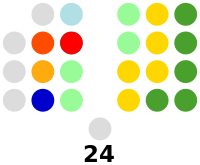 | |
| Senate political groups | Bulk bloc (20)
Minority bloc (4)
|
 | |
| House of Representatives political groups | Majority bloc (268)
Minority bloc (25)
Contained minority bloc (5)
Vacancies (half-dozen)
|
| Joint committees | Articulation committees are chaired by senators |
| Potency | Commodity VI of the Constitution of the Philippines |
| Elections | |
| Senate voting system | Multiple non-transferable vote |
| House of Representatives voting system | Parallel voting (Political party-list proportional representation and outset-past-the-post) |
| Senate concluding election | May xiii, 2019 |
| Business firm of Representatives last election | May 13, 2019 |
| Senate next election | May 9, 2022 |
| Firm of Representatives adjacent ballot | May 9, 2022 |
| Meeting identify | |
 | |
| Joint sessions are usually held at the Batasang Pambansa Complex, Quezon Urban center | |
| Website | |
| Senate of the Philippines House of Representatives of the Philippines | |
The Congress of the Philippines (Filipino: Kongreso ng Pilipinas) is the bicameral legislature of the Philippines. It consists of the Senate (upper house) and the House of Representatives (lower house),[1] although colloquially, the term "Congress" commonly refers to simply the latter.[a]
The Senate is composed of 24 senators[two] half of which are elected every three years. Each senator, therefore, serves a full of six years. The senators are elected by the whole electorate and exercise not represent whatsoever geographical district.
In the ongoing 18th Congress, there are 304 seats in the House of Representatives. The Constitution states that the House "shall exist composed of not more than 250 members, unless otherwise stock-still by police," and that at to the lowest degree 20% of information technology shall be sectoral representatives. In that location are ii types of congressmen: the district and the sectoral representatives. At the fourth dimension of the ratification of the constitution, there were 200 districts, leaving 50 seats for sectoral representatives.
The district congressmen stand for a item congressional district of the state. All provinces in the land are composed of at least one congressional district. Several cities besides accept their ain congressional districts, with some having two or more representatives.[1] From 200 districts in 1987, the number of districts have increased to 243. Every new Congress has seen an increase in the number of districts.
The party-list congressmen represent the minority sectors of the population. This enables these minority groups to be represented in the Congress, when they would otherwise non exist represented properly through district representation. Also known every bit party-list representatives, sectoral congressmen correspond labor unions, rights groups, and other organizations.[one] With the increase of districts besides means that the seats for party-list representatives increase also, as the i:4 ratio has to be respected.
The Constitution provides that Congress shall convene for its regular session every year beginning on the 4th Monday of July. A regular session can concluding until thirty days before the opening of its next regular session in the succeeding year. The president may, even so, telephone call special sessions which are normally held between regular legislative sessions to handle emergencies or urgent matters.[one]
History [edit]
Spanish era [edit]
During the Castilian colonization of the Philippines, municipal governments, or Cabildos were established. One such case was the Cabildo in Manila, established in 1571.[three]
When the Philippines was under colonial dominion every bit part of the Spanish E Indies, the colony was not given representation to the Spanish Cortes. Information technology was simply in 1809 where the colony was fabricated an integral part of Spain and was given representation in the Cortes. While colonies such as the Philippines were selecting its delegates, substitutes were named so that the Cortes can convene. The substitutes, and first delegates for the Philippines were Pedro Pérez de Tagle and José Manuel Couto. Both had no connections to the colony.[4]
By July 1810, Governor General Manuel González de Aguilar received the instruction to hold an ballot. As only the Manila Municipal Council qualified to elect a representative, information technology was tasked to select a delegate. Three of its representatives, the governor-general and the Archbishop of Manila selected Ventura de los Reyes every bit Manila'southward delegate to the Cortes. De los Reyes arrived in Cadiz in December 1811.[4]
However, with Napoleon I's defeat at the Boxing of Waterloo, his brother Joseph Bonaparte was removed from the Castilian throne, and the Cádiz Constitution was replaced by the Cortes on May 24, 1816, with a more conservative constitution that removed Philippine representation on the Cortes, among other things. Restoration of Philippine representation to the Cortes was i of the grievances by the Ilustrados, the educated class during the late 19th century.[two]
Revolutionary era [edit]
The Illustrados' campaign transformed into the Philippine Revolution that aimed to overthrow Castilian rule. Proclaiming independence on June 12, 1898, President Emilio Aguinaldo then ordered the convening of a revolutionary congress at Malolos. The Malolos Congress, among other things, approved the Malolos Constitution. With the approval of the Treaty of Paris, the Spanish ceded the Philippines to the U.s.a.. The revolutionaries, attempting to prevent American conquest, launched the Philippine–American War, just were defeated when Aguinaldo was captured in 1901.[ii]
American era [edit]
When the Philippines was under American colonial dominion, the legislative body was the Philippine Commission which existed from 1900 to 1907. The President of the United States appointed the members of the Philippine Commission. Furthermore, two Filipinos served every bit Resident Commissioners to the Business firm of Representatives of the U.s.a. from 1907 to 1935, then but i from 1935 to 1946. The Resident Commissioners had a voice in the Firm, merely did not accept voting rights.[ii]
The Philippine Bill of 1902 mandated the creation of a bicameral or a two-bedroom Philippine Legislature with the Philippine Commission equally the Upper House and the Philippine Associates every bit the Lower House. This bicameral legislature was inaugurated in 1907. Through the leadership of then Speaker Sergio Osmeña and so-Floor Leader Manuel L. Quezon, the Rules of the 59th United states of america Congress were essentially adopted as the Rules of the Philippine Legislature.[2]
In 1916, the Jones Police force changed the legislative system. The Philippine Commission was abolished, and a new bicameral Philippine Legislature consisting of a House of Representatives and a Senate was established.[2]
Commonwealth and Second Democracy era [edit]
The legislative system was inverse over again in 1935. The 1935 Constitution, aside from instituting the Commonwealth which gave the Filipinos more role in regime, established a unicameral National Associates. Merely in 1940, through an amendment to the 1935 Constitution, a bicameral Congress of the Philippines consisting of a Business firm of Representatives and a Senate was created. Those elected in 1941 would not serve until 1945, as Globe War II erupted. The invading Japanese set up the 2nd Philippine Commonwealth and convened its own National Associates. With the Japanese defeat in 1945, the Republic and its Congress was restored. The same setup continued until the Americans granted independence on July four, 1946.[2]
Contained era [edit]
Upon the inauguration of the Republic of the Philippines on July 4, 1946, Republic Act No. 6 was enacted providing that on the date of the proclamation of the Republic of the Philippines, the existing Congress would be known as the Get-go Congress of the Republic. Successive Congresses were elected until President Ferdinand Marcos declared martial police on September 23, 1972. Marcos and so ruled by decree.[2]
As early on as 1970, Marcos had convened a constitutional convention to revise the 1935 constitution; in 1973, the Constitution was approved. Information technology abolished the bicameral Congress and created a unicameral National Assembly, which would ultimately be known as the Batasang Pambansa in a semi-presidential system of government. The batasan elected a prime minister. The Batasang Pambansa starting time convened in 1978. [two]
Marcos was overthrown later the 1986 People Ability Revolution; President Corazon Aquino then ruled past decree. Later on that year she appointed a constitutional commission that drafted a new constitution. The Constitution was approved in a referendum the side by side year; it restored the presidential system of government together with a bicameral Congress of the Philippines. It starting time convened in 1987.[2]
Seat [edit]
Locations of the historical (blueish) and current (red) seats of Congress in Metro Manila.
The two houses of Congress meet at different places in Metro Manila, the seat of government: the Senate meets at the GSIS Building, the main office of the Regime Service Insurance System (GSIS) at Pasay, while the House of Representatives sits at the Batasang Pambansa Circuitous in Quezon City. The two are around 25 kilometers (sixteen mi) apart.
The Barasoain Church in Malolos, Bulacan served as a meeting place of unicameral congress of the First Philippine Commonwealth.
Subsequently the Americans defeated the Starting time Republic, the United states-instituted Philippine Legislature convened at the Ayuntamiento in Intramuros, Manila from 1907 to 1926, when it transferred to the Legislative Building only outside Intramuros. In the Legislative Edifice, the Senate occupied the upper floors while the Firm of Representatives used the lower floors.
With the Legislative Building destroyed during the Battle of Manila of 1945, the Commonwealth Congress convened at the Old Japanese Schoolhouse at Sampaloc. Congress met at the schoolhouse auditorium, with the Senate convening on evenings and the Firm of Representatives meeting every morning. The Senate later on moved to the Manila Urban center Hall, with the House staying in the schoolhouse. The two chambers of Congress returned to the reconstructed Legislative Edifice, now the Congress Building in 1950. In 1973, when President Marcos ruled past decree, Congress was padlocked. Marcos built a new seat of a unicameral parliament at Quezon Metropolis, which would eventually be the Batasang Pambansa Complex. The parliament that will eventually be named as the Batasang Pambansa (National Legislature), beginning met at the Batasang Pambansa Complex in 1978.
With the overthrow of Marcos after the People Power Revolution, the bicameral Congress was restored. The Firm of Representatives inherited the Batasang Pambansa Circuitous, while the Senate returned to the Congress Edifice. In May 1997, the Senate moved to the newly constructed building owned past the GSIS on land reclaimed from Manila Bay at Pasay; the Congress Edifice was eventually transformed into the National Museum of Fine Arts. The Senate will eventually motility into a new building that they would ain in Fort Bonifacio, Taguig.
Powers [edit]
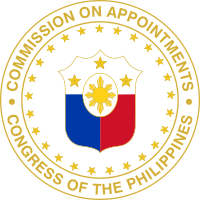
Commission on Appointments
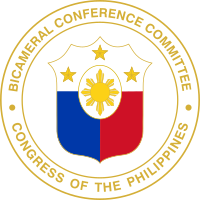
Bicameral Conference Committee
The powers of the Congress of the Philippines may exist classified every bit:
| General Legislative It consists of the enactment of laws intended every bit a rule of bear to govern the relation between individuals (i.e., ceremonious laws, commercial laws, etc.) or betwixt individuals and the land (i.east., criminal law, political constabulary, etc.)[2] | Implied Powers Information technology is essential to the constructive practice of other powers expressly granted to the assembly. | Inherent Powers These are the powers which though not expressly given are yet exercised by the Congress as they are necessary for its existence such every bit:
| Specific Legislative It has reference to powers which the Constitution expressly and specifically directs to perform or execute. Powers enjoyed by the Congress classifiable under this category are:
|
| Executive Powers of the Congress that are executive in nature are:
| Supervisory The Congress of the Philippines exercises considerable control and supervision over the administrative co-operative - e.g.:
| Electoral Considered as electoral ability of the Congress of the Philippines are the Congress' power to:
| Judicial Constitutionally, each house has judicial powers:
|
| Miscellaneous The other powers of Congress mandated past the Constitution are as follows:
| |||
Lawmaking [edit]
- Grooming of the neb
- The Member or the Beak Drafting Sectionalization of the Reference and Inquiry Bureau prepares and drafts the pecker upon the Fellow member's request.
- Get-go reading
- The beak is filed with the Bills and Index Service and the same is numbered and reproduced.
- Iii days after its filing, the aforementioned is included in the Order of Business organisation for Outset Reading.
- On Start Reading, the Secretary General reads the championship and number of the bill. The Speaker refers the nib to the appropriate Committee/s.
- Committee consideration / activeness
- The Committee where the bill was referred to evaluates it to make up one's mind the necessity of conducting public hearings.
-
- If the Commission finds information technology necessary to conduct public hearings, it schedules the time thereof, problems public notices and invites resource persons from the public and private sectors, the academe, and experts on the proposed legislation.
- If the Commission determines that public hearing is not needed, information technology schedules the pecker for Committee discussion/s.
- Based on the result of the public hearings or Committee discussions, the Commission may introduce amendments, consolidate bills on the same subject matter, or propose a substitute beak. Information technology then prepares the respective committee study.
- The Committee approves the Committee Report and formally transmits the same to the Plenary Affairs Agency.
- 2nd reading
- The Committee Report is registered and numbered by the Bills and Index Service. It is included in the Gild of Concern and referred to the Committee on Rules.
- The Commission on Rules schedules the bill for consideration on Second Reading.
- On Second Reading, the Secretarial assistant General reads the number, title and text of the neb and the following takes place:
-
- Menstruation of Sponsorship and Debate
- Menstruum of Amendments
- Voting, which may be by
-
- viva voce
- count past tellers
- partitioning of the Business firm
- nominal voting
- Third reading
- The amendments, if any, are engrossed and printed copies of the bill are reproduced for Third Reading.
- The engrossed bill is included in the Calendar of Bills for Tertiary Reading and copies of the same are distributed to all the Members three days before its Third Reading.
- On 3rd Reading, the Secretary General reads simply the number and championship of the bill.
- A coil call or nominal voting is chosen and a Member, if he desires, is given three minutes to explicate his vote. No subpoena on the bill is allowed at this stage.
-
- The beak is approved by an affirmative vote of a majority of the Members nowadays.
- If the neb is disapproved, the same is transmitted to the Archives.
- Transmittal of the approved bill to the Senate
- The approved bill is transmitted to the Senate for its concurrence.
- Senate action on approved bill of the Firm
- The bill undergoes the same legislative process in the Senate.
- Conference committee
- A Conference Committee is constituted and is composed of Members from each House of Congress to settle, reconcile or thresh out differences or disagreements on whatever provision of the bill.
- The conferees are not express to reconciling the differences in the pecker only may innovate new provisions germane to the subject matter or may study out an entirely new nib on the subject.
- The Conference Committee prepares a report to exist signed past all the conferees and the chairman.
- The Conference Committee Report is submitted for consideration/approval of both Houses. No amendment is allowed.
- Transmittal of the bill to the President
- Copies of the bill, signed by the Senate President and the Speaker of the Firm of Representatives and certified past both the Secretary of the Senate and the Secretary General of the Business firm, are transmitted to the President.
- Presidential activity on the nib
- If the nib is approved past the President, information technology is assigned an RA number and transmitted to the House where it originated.
- Action on canonical pecker
- The bill is reproduced and copies are sent to the Official Gazette Part for publication and distribution to the implementing agencies. It is so included in the annual compilation of Acts and Resolutions.
- Action on vetoed bill
- The message is included in the Order of Concern. If the Congress decides to override the veto, the House and the Senate shall proceed separately to reconsider the bill or the vetoed items of the bill. If the bill or its vetoed items is passed past a vote of ii-thirds of the Members of each Firm, such bill or items shall go a constabulary.
Composition [edit]
In the diagrams below, Congress is divided in blocs, with the colors referring to the political party of the person leading that bloc. The blocs are determined past the vote of the member in speakership or Senate presidential elections.
The Senate is equanimous of the winners of the 2022 and 2022 Senate elections. The House of Representatives is composed of the winners of the 2022 House of Representatives elections. In both chambers, the majority bloc is composed of members generally supportive of the presidency of Rodrigo Duterte, while the minority blocs are those opposed. In the Business firm of Representatives, there is an independent minority bloc, and 4 vacant seats.
In both chambers, membership in committees is adamant past the size of the bloc; only members of the majority and minority blocs are given committee memberships. In the Philippines, political parties are liquid, and it is non uncommon to see partymates encounter themselves on dissimilar blocs.
Leadership [edit]
Each sleeping accommodation is headed by a presiding officer, both elected from their corresponding membership; in the Senate, it is the Senate President, while in the Business firm of Representatives, information technology is the Speaker. The Senate also has a Senate president pro tempore, and the Business firm of Representatives has deputy speakers. Each sleeping accommodation has its own flooring leaders.
| Senate | House of Representatives | |||||||
|---|---|---|---|---|---|---|---|---|
| Position | Holder | Party | Position | Holder | Party | District/Party-listing | ||
| President | Tito Sotto | NPC | Speaker | Lord Allan Velasco | PDP–Laban | Marinduque–lone | ||
| President pro tempore | Ralph Recto | Nacionalista | Deputy Speakers | Paolo Duterte | NUP | Davao Metropolis–1st | ||
| Ferdinand Hernandez | PDP–Laban | Due south Cotabato–2nd | ||||||
| Evelina Escudero | NPC | Sorsogon–1st | ||||||
| Loren Legarda | NPC | Antique–solitary | ||||||
| Conrado Estrella 3 | Abono | Party-listing | ||||||
| Prospero Pichay Jr. | Lakas | Surigao del Sur–1st | ||||||
| Roberto Puno | NUP | Antipolo–1st | ||||||
| Eddie Villanueva | CIBAC | Party-list | ||||||
| Neptali Gonzales 2 | PDP–Laban | Mandaluyong–lone | ||||||
| Rosemarie Arenas | PDP–Laban | Pangasinan–3rd | ||||||
| Rodante Marcoleta | SAGIP | Political party-list | ||||||
| Henry Oaminal | Nacionalista | Misamis Occidental–2nd | ||||||
| Pablo John Garcia | NUP | Cebu–3rd | ||||||
| Vilma Santos | Nacionalista | Batangas–6th | ||||||
| Deogracias Victor Savellano | Nacionalista | Ilocos Sur–1st | ||||||
| Mujiv Hataman | Liberal | Basilan–lone | ||||||
| Mikee Romero | 1-PACMAN | Party-list | ||||||
| Paulino Salvador Leachon | PDP–Laban | Oriental Mindoro–1st | ||||||
| Lito Atienza | Buhay | Party-list | ||||||
| Rufus Rodriguez | CDP | Cagayan de Oro–2nd | ||||||
| Arnolfo Teves Jr. | PDP–Laban | Negros Oriental–third | ||||||
| Benny Abante | NUP | Manila–sixth | ||||||
| Weslie Gatchalian | NPC | Valenzuela–1st | ||||||
| Eric Martinez | PDP–Laban | Valenzuela–2nd | ||||||
| Juan Pablo Bondoc | PDP–Laban | Pampanga–4th | ||||||
| Bernadette Herrera-Dy | BH | Political party-listing | ||||||
| Divina Grace Yu | PDP–Laban | Zamboanga del Sur–1st | ||||||
| Rogelio Pacquiao | PDP–Laban | Sarangani–lonely | ||||||
| Kristine Singson-Meehan | Bileg | Ilocos Sur–2nd | ||||||
| Strike Revilla | NUP | Cavite–2nd | ||||||
| Isidro Ungab | HNP | Davao City–3rd | ||||||
| Abraham Tolentino | NUP | Cavite–eighth | ||||||
| Camille Villar | Nacionalista | Las Piñas–lone | ||||||
| Bulk Leader | Juan Miguel Zubiri | Independent | Bulk Leader | Martin Romualdez | Lakas | Leyte–1st | ||
| Minority Leader | Franklin Drilon | Liberal | Minority Leader | Joseph Stephen Paduano | Abang Lingkod | Party-list | ||
Summary [edit]
Voting requirements [edit]
The vote requirements in the Congress of the Philippines are equally follows:
| Requirement | Senate | Firm of Representatives | Joint session | All members |
|---|---|---|---|---|
| One-fifth |
| N/A | N/A | |
| One-third | N/A |
| Northward/A | N/A |
| Majority (fifty% +1 member) |
|
|
|
|
| ||||
| Ii-thirds |
|
|
| |
| Due north/A | |||
| Three-fourths | N/A | N/A | Northward/A |
|
In virtually cases, such equally the approval of bills, simply a majority of members present is needed; on some cases such as the ballot of presiding officers, a majority of all members, including vacant seats, is needed.
Sessions [edit]
A new session of Congress starts after every Business firm of Representatives election. During the performance of the 1935 constitution as amended in 1940, mid-term elections in the Senate crusade its membership to be changed mid-session. From 1945 to 1972, at that place were two commonwealth congresses and seven congresses of the republic, with the 2nd Republic Congress becoming the 1st Congress of the Republic. During the usage of the 1973 constitution, the Batasang Pambansa was the legislature, with it having two elections. Starting in the 1987 constitution, each Senate election was synchronized with the House elections, with the first congress under that constitution being counted as the "eighth Congress", picking upward from the last congress of the 1935 constitution.
Per historical era [edit]
| In performance | Authority | Regime | Legislature | Type | Upper business firm | Lower house |
|---|---|---|---|---|---|---|
| 1898–99 | Malolos Constitution | | Malolos Congress | Unicameral | Malolos Congress | |
| State of war powers dominance of the President of the United states of america | | Martial constabulary; military governor ruled by decree | ||||
| 1900–1902 | Malolos Constitution | | Malolos Congress | Unicameral | Malolos Congress | |
| Appointment by the President of the Usa | | Taft Committee | Unicameral | Philippine Committee | ||
| 1902–1907 | Philippine Organic Act | | Philippine Commission | Unicameral | ||
| 1907–1916 | Philippine Legislature | Bicameral | Philippine Commission | Philippine Assembly | ||
| 1916–1935 | Philippine Autonomy Act | Bicameral | Senate | House of Representatives | ||
| 1935–1941 | 1935 Constitution | | National Assembly | Unicameral | National Assembly | |
| 1942–43 | War powers authorisation of the Emperor of Japan | | Martial constabulary; governor-full general ruled by decree | |||
| 1943–44 | 1943 Constitution | | National Assembly | Unicameral | National Associates | |
| 1945–46 | Amendments to the 1935 Constitution | | Congress (Commonwealth) | Bicameral | Senate | House of Representatives |
| 1946–1973 | | Congress | Bicameral | |||
| 1973–1976 | 1973 Constitution | | Martial law; president ruled past decree | |||
| 1976–1978 (never convened) | Batasang Bayan | Unicameral | National Assembly | |||
| 1978–1986 | Amendments to the 1973 Constitution | | Batasang Pambansa | Unicameral | Batasang Pambansa | |
| 1986–1987 | | President ruled past decree | ||||
| 1987–present | 1987 Constitution | | Congress | Bicameral | Senate | House of Representatives |
Listing of Congresses [edit]
| Ballot | Congress | Senate election results | House of Representatives elections results | ||
|---|---|---|---|---|---|
| Pre-1941 | See Philippine Legislature and National Assembly of the Philippines | ||||
| 1941 | 1st Commonwealth Congress |  | 24 Nacionalista | 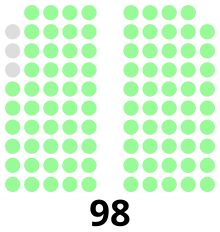 | 95 Nacionalista three independent |
| 1946 | 2d Commonwealth Congress |  | ix Nacionalista (Liberal wing) six Nacionalista 1 Popular Forepart | 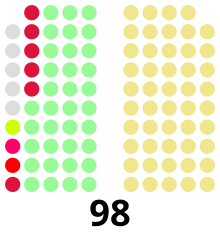 | 49 Nacionalista (Liberal wing) 35 Nacionalista half-dozen Autonomous Alliance 3 others |
| 1st Congress | |||||
| 1947 |  | six Liberal 2 Nacionalista | |||
| 1949 | 2nd Congress |  | viii Liberal |  | 60 Liberal 33 Nacionalista 7 others |
| 1951 |  | 8 Nacionalista | |||
| 1953 | third Congress |  | five Nacionalista two Democratic 1 Citizens' |  | 59 Nacionalista 31 Liberal xi Autonomous 1 contained |
| 1955 | 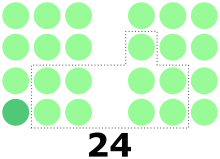 | 9 Nacionalista | |||
| 1957 | 4th Congress |  | half dozen Nacionalista 2 Liberal |  | 82 Nacionalista 19 Liberal 1 NCP |
| 1959 |  | v Nacionalista 2 Liberal one NCP | |||
| 1961 | 5th Congress |  | iv Liberal two Nacionalista ii Progressive |  | 74 Nacionalista 29 Liberal 1 independent |
| 1963 | 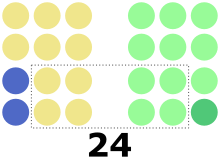 | 4 Liberal 4 Nacionalista | |||
| 1965 | sixth Congress | 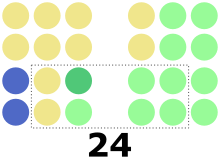 | 5 Nacionalista ii Liberal ane NCP |  | 61 Liberal 38 Nacionalista v others |
| 1967 |  | 6 Nacionalista one Liberal 1 independent | |||
| 1969 | 7th Congress |  | half-dozen Nacionalista 2 Liberal | 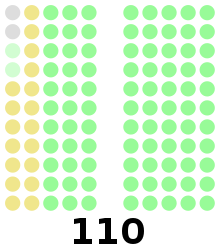 | 88 Nacionalista 18 Liberal 4 others |
| 1971 | 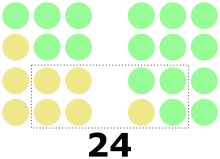 | 5 Liberal 3 Nacionalista | |||
| 1978, 1984 | Meet Batasang Pambansa | ||||
| 1987 | 8th Congress |  | 22 LABAN 2 GAD |  | 43 PDP–Laban 24 Lakas ng Bansa 19 UNIDO xvi Liberal 11 KBL 55 coalitions 32 others xiv appointed sectoral seats |
| 1992 | 9th Congress |  | xvi LDP v NPC 2 Lakas 1 Liberal | 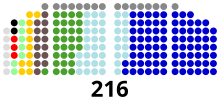 | 86 LDP 41 Lakas 30 NPC xi LP-PDP 32 others 16 appointed sectoral seats |
| 1995 | tenth Congress |  | 4 Lakas 4 LDP 1 Nacionalista 1 NPC 1 PRP 1 independent |  | 157 pro-administration coalition 26 opposition coalition 12 hybrid coalitions ix others xvi appointed sectoral seats |
| 1998 | 11th Congress |  | 5 Lakas 4 LDP one NPC one PMP 1 PDP–Laban |  | 111 Lakas 55 LAMMP fifteen Liberal 25 others 14 party-lists |
| 2001 | 12th Congress |  | 3 Lakas ii LDP 1 Liberal 1 PDP–Laban 6 independent |  | 73 Lakas forty NPC 21 LDP xix Liberal 52 others 17 political party-lists |
| 2004 | 13th Congress |  | v KNP 4 Lakas two Liberal one PRP |  | 92 Lakas 53 NPC 29 Liberal fifteen LDP 20 others 28 party-lists |
| 2007 | 14th Congress |  | two Liberal two Nacionalista 2 NPC 2 UNO 1 KAMPI 1 LDP 1 PDP–Laban i independent |  | 89 Lakas 44 KAMPI 28 NPC 23 Liberal 11 Nacionalista 23 others 53 party-lists |
| 2010 | 15th Congress |  | iii Liberal 2 Lakas–Kampi ii Nacionalista two PMP 1 NPC 1 PRP 1 independent |  | 106 Lakas–Kampi 47 Liberal 29 NPC 25 Nacionalista 22 others 57 party-lists |
| 2013 | 16th Congress |  | three Nacionalista 3 UNA 1 LDP 1 Liberal 1 NPC one PDP–Laban |  | 109 Liberal 42 NPC 24 NUP 18 Nacionalista 14 Lakas 27 others 59 party-lists |
| 2016 | 17th Congress | 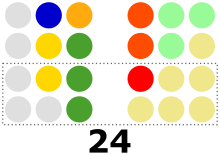 | 5 Liberal two NPC 1 Akbayan ane UNA 3 independent |  | 115 Liberal 42 NPC 24 Nacionalista 23 NUP 11 UNA 23 others 59 party-lists |
| 2019 | 18th Congress |  | 4 PDP–Laban 3 Nacionalista ane Lakas one LDP 1 NPC 1 UNA i independent |  | 82 PDP–Laban 42 Nacionalista 37 NPC 23 NUP 18 Liberal 12 Lakas 27 others 61 political party-lists |
Latest elections [edit]
Senate [edit]
In the Philippines, the most common style to illustrate the result in a Senate ballot is via a tally of candidates in descending order of votes. The twelve candidates with the highest number of votes are elected.
| # | Candidate | Coalition | Party | Votes | % | ||
|---|---|---|---|---|---|---|---|
| 1. | Cynthia Villar | HNP | Nacionalista | 25,283,727 | 53.46% | ||
| 2. | Grace Poe | Independent | 22,029,788 | 46.58% | |||
| iii. | Bong Go | HNP | PDP–Laban | 20,657,702 | 42.35% | ||
| 4. | Pia Cayetano | HNP | Nacionalista | nineteen,789,019 | 41.84% | ||
| v. | Ronald dela Rosa | HNP | PDP–Laban | 19,004,225 | twoscore.18% | ||
| half-dozen. | Sonny Angara | HNP | LDP | 18,161,862 | 38.xl% | ||
| 7. | Lito Lapid | NPC | sixteen,965,464 | 35.87% | |||
| 8. | Imee Marcos | HNP | Nacionalista | 15,882,628 | 33.58% | ||
| nine. | Francis Tolentino | HNP | PDP–Laban | xv,510,026 | 32.79% | ||
| x. | Koko Pimentel | HNP | PDP–Laban | 14,668,665 | 31.01% | ||
| 11. | Bell Revilla | HNP | Lakas | 14,624,445 | thirty.92% | ||
| 12. | Nancy Binay | UNA | UNA | fourteen,504,936 | 30.67% | ||
| thirteen. | JV Ejercito | HNP | NPC | 14,313,727 | 30.26% | ||
| fourteen. | Bam Aquino | Otso Diretso | Liberal | 14,144,923 | 29.91% | ||
| 15. | Jinggoy Estrada | HNP | PMP | 11,359,305 | 24.02% | ||
| 16. | Mar Roxas | Otso Diretso | Liberal | 9,843,288 | twenty.81% | ||
| 17. | Serge Osmeña | Independent | 9,455,202 | 19.99% | |||
| eighteen. | Willie Ong | Lakas | 7,616,265 | sixteen.12% | |||
| 19. | Dong Mangudadatu | HNP | PDP–Laban | seven,499,604 | 15.86% | ||
| twenty. | Jiggy Manicad | HNP | Independent | 6,896,889 | 14.58% | ||
| 21. | Chel Diokno | Otso Diretso | Liberal | half-dozen,342,939 | 13.41% | ||
| 22. | Juan Ponce Enrile | PMP | five,319,298 | eleven.25% | |||
| 23. | Gary Alejano | Otso Diretso | Liberal | 4,726,652 | nine.99% | ||
| 24. | Neri Colmenares | Labor Win | Makabayan | 4,683,942 | 9.90% | ||
| 25. | Samira Gutoc | Otso Diretso | Liberal | iv,345,252 | 9.xix% | ||
| 26. | Romulo Macalintal | Otso Diretso | Contained | iv,007,339 | 8.47% | ||
| 27. | Erin Tañada | Otso Diretso | Liberal | 3,870,529 | eight.eighteen% | ||
| 28. | Larry Gadon | KDP | KBL | iii,487,780 | 7.37% | ||
| 29. | Florin Hilbay | Otso Diretso | Aksyon | 2,757,879 | 5.83% | ||
| xxx. | Freddie Aguilar | Contained | 2,580,230 | 5.46% | |||
| 31. | Glenn Chong | KDP | KDP | ii,534,335 | five.36% | ||
| 32. | Raffy Alunan | Bagumbayan | 2,059,359 | 4.35% | |||
| 33. | Faisal Mangondato | KKK | Independent | 1,988,719 | 4.20% | ||
| 34. | Agnes Escudero | KKK | Contained | ane,545,985 | 3.27% | ||
| 35. | Dado Padilla | PFP | 1,095,337 | 2.32% | |||
| 36. | Ernesto Arellano | Independent | 937,713 | 2.thirty% | |||
| 37. | Allan Montaño | Labor Win | Independent | 923,419 | 2.25% | ||
| 38. | Leody de Guzman | Labor Win | PLM | 893,506 | 2.17% | ||
| 39. | Melchor Chavez | WPP | WPP | 764,473 | 2.06% | ||
| 40. | Vanjie Abejo | KKK | Contained | 656,006 | 2.00% | ||
| 41. | Toti Casiño | KDP | KDP | 580,853 | 1.97% | ||
| 42. | Abner Afuang | WPP | WPP | 559,001 | 1.92% | ||
| 43. | Shariff Albani | WPP | WPP | 496,855 | i.87% | ||
| 44. | Dan Roleda | UNA | UNA | 469,840 | 1.80% | ||
| 45. | Ding Generoso | KKK | Independent | 449,785 | one.75% | ||
| 46. | Nur-Ana Sahidulla | KDP | KDP | 444,096 | 1.68% | ||
| 47. | Abraham Jangao | Independent | 434,697 | 1.65% | |||
| 48. | Marcelino Arias | WPP | WPP | 404,513 | 1.59% | ||
| 49. | Richard Alfajora | KKK | Contained | 404,513 | 1.57% | ||
| 50. | Sonny Matula | Labor Win, WPP | WPP | 400,339 | 1.l% | ||
| 51. | Elmer Francisco | PFP | 395,427 | 1.45% | |||
| 52. | Joan Sheelah Nalliw | KKK | Independent | 390,165 | i.38% | ||
| 53. | Gerald Arcega | WPP | WPP | 383,749 | i.xxx% | ||
| 54. | Butch Valdes | KDP | KDP | 367,851 | 1.twenty% | ||
| 55. | Jesus Caceres | KKK | Independent | 358,472 | 0.90% | ||
| 56. | Bernard Austria | PDSP | 347,013 | 0.70% | |||
| 57. | Jonathan Baldevarona | Independent | 310,411 | 0.67% | |||
| 58. | Emily Mallillin | KKK | Independent | 304,215 | 0.64% | ||
| 59. | Charlie Gaddi | KKK | Independent | 286,361 | 0.50% | ||
| 60. | RJ Javellana | KDP | KDP | 258,538 | 0.47% | ||
| 61. | Junbert Guigayuma | WPP | WPP | 240,306 | 0.40% | ||
| 62. | Luther Meniano | WPP | WPP | 159,774 | 0.30% | ||
| Total turnout | 47,296,442 | 74.31% | |||||
| Full votes | 362,179,156 | N/A | |||||
| Registered voters | 63,643,263 | 100.0% | |||||
| Reference: Commission on Elections sitting as the National Lath of Canvassers. | |||||||
House of Representatives [edit]
A voter has two votes in the Firm of Representatives: one vote for a representative elected in the voter'southward congressional district (first-by-the-post), and one vote for a party in the party-list system (closed list), the so-called party-list representatives; party-list representatives shall comprise not more than 20% of the Business firm of Representatives.
To make up one's mind the winning parties in the party-list election, a political party must surpass the 2% election threshold of the national vote; usually, the party with the largest number of votes wins the maximum 3 seats, the rest ii seats. If the number of seats of the parties that surpassed the 2% threshold is less than 20% of the full seats, the parties that won less than 2% of the vote gets 1 seat each until the twenty% requirement is met.
District elections [edit]
 | ||||||
| Party | Votes | % | +/– | Seats | +/– | |
|---|---|---|---|---|---|---|
| Partido Demokratiko Pilipino-Lakas ng Bayan | 12,653,960 | 31.22 | +29.32 | 82 | +79 | |
| Nacionalista Party | 6,524,100 | 16.10 | +six.68 | 42 | +18 | |
| Nationalist People's Coalition | 5,797,543 | xiv.31 | −2.73 | 37 | −5 | |
| National Unity Party | three,852,909 | nine.51 | −0.xvi | 25 | +2 | |
| Liberal Party | two,321,759 | 5.73 | −35.99 | eighteen | −97 | |
| Lakas-CMD | 2,069,871 | 5.11 | +3.57 | 12 | +8 | |
| Partido Federal ng Pilipinas | 965,048 | 2.38 | New | v | New | |
| Hugpong ng Pagbabago | 652,318 | 1.61 | New | 3 | New | |
| Aksyon Demokratiko | 398,616 | 0.98 | −0.4 | i | 0 | |
| Pwersa ng Masang Pilipino | 396,614 | 0.98 | +0.77 | i | New | |
| Bukidnon Paglaum | 335,628 | 0.83 | +0.48 | 2 | +one | |
| Pederalismo ng Dugong Dakilang Samahan | 259,423 | 0.64 | New | 0 | 0 | |
| Laban ng Demokratikong Pilipino | 252,806 | 0.62 | +0.32 | 2 | 0 | |
| United Nationalist Alliance | 232,657 | 0.57 | −6.05 | 0 | −eleven | |
| Hugpong sa Tawong Lungsod | 197,024 | 0.49 | +0.35 | 1 | New | |
| Partidong Pagbabago ng Palawan | 185,810 | 0.46 | New | 2 | New | |
| Bileg Ti Ilokano | 158,523 | 0.39 | New | one | New | |
| People's Reform Party | 138,014 | 0.34 | New | one | New | |
| Unang Sigaw ng Nueva Ecija | 120,674 | 0.30 | New | 0 | 0 | |
| Katipunan ng Demokratikong Pilipino | 116,453 | 0.29 | New | 0 | 0 | |
| Asenso Abrenio | 115,865 | 0.29 | New | 1 | New | |
| Kambilan ning Memalen Kapampangan | 107,078 | 0.26 | New | 0 | 0 | |
| Padayon Pilipino | 98,450 | 0.24 | −0.10 | 0 | 0 | |
| Asenso Manileño | 84,656 | 0.21 | −0.29 | 2 | 0 | |
| Kusog Bicolandia | 82,832 | 0.20 | New | 0 | 0 | |
| Centrist Democratic Party of the Philippines | 81,741 | 0.20 | +0.16 | one | New | |
| Partido Navoteño | lxxx,265 | 0.20 | New | 1 | New | |
| Kabalikat ng Bayan sa Kaunlaran | 65,836 | 0.16 | −0.03 | one | 0 | |
| Partido Demokratiko Sosyalista ng Pilipinas | 56,223 | 0.14 | New | 0 | 0 | |
| Bagumbayan-VNP | 33,731 | 0.08 | New | 0 | 0 | |
| Kilusang Bagong Lipunan | 33,594 | 0.08 | −0.45 | 0 | 0 | |
| Adelante Zamboanga Party | 28,605 | 0.07 | New | 0 | 0 | |
| Labor Party Philippines | 9,718 | 0.02 | +0.00 | 0 | 0 | |
| Democratic Political party of the Philippines | 1,110 | 0.00 | New | 0 | 0 | |
| Hugpong Surigao Sur | 816 | 0.00 | New | 0 | 0 | |
| Philippine Green Republican Party | 701 | 0.00 | −0.01 | 0 | 0 | |
| Independent | 2,014,211 | 4.97 | −0.86 | 2 | −2 | |
| Party-list seats[b] | 61 | +2 | ||||
| Full | 40,525,182 | 100.00 | – | 304 | +five | |
| Valid votes | forty,525,182 | 86.34 | ||||
| Invalid/blank votes | 6,411,957 | 13.66 | ||||
| Total votes | 46,937,139 | – | ||||
| Registered voters/turnout | 61,843,771 | 75.90 | ||||
| Source: COMELEC (Seats won), (Turnout and electorate) | ||||||
- ^ The URL of the website of the House of Representatives is, for example, www.congress.gov.ph.
- ^ At that place were supposed to exist 306 seats up, out of 245 districts and 61 party-seats. Elections at 2 districts were deferred after ballots were already printed using the old configuration. Afterward the political party-list seats were seated, the Supreme Court then ruled that one of the districts shall first disputed in the 2022 election, and that the results of the 2022 election using the erstwhile configuration stood. The Committee on Elections and then ruled that for other district, the aforementioned ruling from the Supreme Court would besides be followed. This reduced the number of congressional district seats to 243, and would accept meant a reduction of 1 party-list seat, but that was no longer acted upon.
Party-list election [edit]
| Party | Votes | % | +/– | Seats | +/– | |
|---|---|---|---|---|---|---|
| Anti-Crime and Terrorism Community Involvement and Support | 2,651,987 | 9.51 | +ix.17 | 3 | New | |
| Bayan Muna | one,117,403 | 4.01 | +2.fourteen | 3 | +two | |
| Ako Bicol Political Political party | ane,049,040 | 3.76 | −i.38 | ii | −1 | |
| Citizens' Boxing Confronting Corruption | 929,718 | iii.33 | +ane.61 | 2 | +one | |
| Alyansa ng mga Mamamayang Probinsyano | 770,344 | 2.76 | New | 2 | New | |
| One Patriotic Coalition of Marginalized Nationals | 713,969 | 2.56 | −1.49 | 2 | 0 | |
| Marino Samahan ng mga Seaman | 681,448 | 2.44 | +two.12 | 2 | New | |
| Probinsyano Ako | 630,435 | ii.26 | New | ii | New | |
| Coalition of Association of Senior Citizens in the Philippines | 516,927 | 1.85 | −one.20 | i | −1 | |
| Magkakasama sa Sakahan Kaunlaran | 496,337 | i.78 | New | 1 | New | |
| Association of Philippine Electric Cooperatives | 480,874 | 1.72 | New | ane | New | |
| Gabriela Women's Party | 449,440 | 1.61 | −2.61 | ane | −1 | |
| An Waray | 442,090 | 1.59 | −0.23 | 1 | 0 | |
| Cooperative NATCCO Network Party | 417,285 | i.50 | −0.57 | one | −ane | |
| Human action Teachers | 395,327 | 1.42 | −2.23 | ane | −one | |
| Philippine Rural Electric Cooperatives Association | 394,966 | 1.42 | New | ane | New | |
| Ako Bisaya | 394,304 | one.41 | New | ane | New | |
| Tingog Sinirangan | 391,211 | ane.40 | +0.75 | 1 | New | |
| Abono | 378,204 | 1.36 | −0.90 | 1 | −1 | |
| Buhay Hayaan Yumabong | 361,493 | 1.thirty | −1.05 | one | −one | |
| Duterte Youth | 354,629 | 1.27 | New | 1 | New | |
| Kalinga-Advancement for Social Empowerment and Nation Edifice Through Easing Poverty | 339,665 | one.22 | New | ane | 0 | |
| Puwersa ng Bayaning Atleta | 326,258 | 1.17 | −1.24 | i | −1 | |
| Brotherhood of Organizations Networks and Associations of the Philippines | 320,000 | 1.15 | −0.xix | 1 | 0 | |
| Rural Electric Consumers and Beneficiaries of Development and Advocacy | 318,511 | 1.14 | New | 1 | New | |
| Bagong Henerasyon | 288,752 | 1.04 | +0.12 | 1 | 0 | |
| Bahay para sa Pamilyang Pilipino | 281,793 | 1.01 | New | one | New | |
| Structure Workers Solidarity | 277,940 | one.00 | +0.97 | 1 | New | |
| Abang Lingkod | 275,199 | 0.99 | −0.45 | 1 | 0 | |
| Advocacy for Teacher Empowerment Through Activity, Cooperation and Harmony Towards Educational Reforms | 274,460 | 0.98 | −0.49 | one | 0 | |
| Barangay Health Health | 269,518 | 0.97 | New | one | New | |
| Social Amelioration and Genuine Intervention on Poverty | 257,313 | 0.92 | −0.31 | 1 | New | |
| Trade Union Congress Party | 256,059 | 0.92 | −0.52 | i | 0 | |
| Magdalo para sa Pilipino | 253,536 | 0.91 | +0.05 | 1 | 0 | |
| Galing sa Puso Political party | 249,484 | 0.89 | New | 1 | New | |
| Manila Teachers Savings and Loan Association | 249,416 | 0.89 | +0.06 | ane | 0 | |
| Rebolusyonaryong Alyansa Makabansa | 238,150 | 0.85 | +0.38 | one | New | |
| Alagaan Natin Ating Kalusugan | 237,629 | 0.85 | +0.26 | 1 | New | |
| Ako Padayon Pilipino | 235,112 | 0.84 | New | one | New | |
| Ang Asosayon Sang Mangunguma Nga Bisaya-Owa Mangunguma | 234,552 | 0.84 | −0.69 | ane | 0 | |
| Kusug Tausug | 228,224 | 0.82 | +0.06 | i | 0 | |
| Dumper Philippines Taxi Drivers Clan | 223,199 | 0.eighty | +0.78 | i | New | |
| Talino at Galing ng Pinoy | 217,525 | 0.78 | +0.51 | i | New | |
| Public Safety Alliance for Transformation and Rule of Law | 216,653 | 0.78 | New | ane | New | |
| Anak Mindanao | 212,323 | 0.76 | −1.42 | 1 | −1 | |
| Agricultural Sector Alliance of the Philippines | 208,752 | 0.75 | −1.08 | ane | 0 | |
| LPG Marketers Association | 208,219 | 0.75 | −0.69 | 1 | 0 | |
| OFW Family Society | 200,881 | 0.72 | +0.09 | 1 | New | |
| Kabalikat ng Mamamayan | 198,571 | 0.71 | −i.89 | 1 | −one | |
| Democratic Independent Workers Clan | 196,385 | 0.seventy | −0.74 | i | New | |
| Kabataan | 195,837 | 0.seventy | −0.23 | 1 | 0 | |
| Aksyon Magsasaka-Partido Tinig ng Masa | 191,804 | 0.69 | New | 0 | 0 | |
| Serbisyo sa Bayan Party | 180,535 | 0.65 | −0.22 | 0 | −2 | |
| Angkla: ang Partido ng mga Pilipinong Marino | 179,909 | 0.65 | −0.39 | 0 | −1 | |
| Akbayan | 173,356 | 0.62 | −i.26 | 0 | −1 | |
| Wow Pilipinas Movement | 172,080 | 0.62 | New | 0 | 0 | |
| Ina na Nagmamahal sa Anak | 170,019 | 0.61 | New | 0 | 0 | |
| You Confronting Corruption and Poverty | 167,826 | 0.sixty | −0.86 | 0 | −1 | |
| Abante Mindanao | 166,883 | 0.sixty | −0.05 | 0 | 0 | |
| Butil Farmers Political party | 164,412 | 0.59 | −0.63 | 0 | −1 | |
| Append | 158,003 | 0.57 | New | 0 | 0 | |
| Anakpawis | 146,511 | 0.53 | −0.60 | 0 | −one | |
| Ang National Coalition of Indigenous People Activeness Na! | 144,291 | 0.52 | −0.46 | 0 | −1 | |
| Ang Nars | 141,263 | 0.51 | −0.17 | 0 | 0 | |
| Partido ng Bayan and Bida | 136,093 | 0.49 | New | 0 | 0 | |
| Kasosyo Producer-Consumer Commutation Association | 134,795 | 0.48 | New | 0 | 0 | |
| Agri-Agra na Reporma para sa Magsasaka ng Pilipinas Motion | 133,505 | 0.48 | −2.10 | 0 | −2 | |
| Acts Overseas Filipino Workers Coalition of Organizations | 131,865 | 0.47 | −0.69 | 0 | −1 | |
| Adhikaing Tinaguyod ng Kooperatiba | 131,344 | 0.47 | +0.10 | 0 | 0 | |
| Ang Mata'y Alagaan | 128,201 | 0.46 | −0.56 | 0 | −1 | |
| 1st Consumers Alliance for Rural Energy | 127,867 | 0.46 | New | 0 | −1 | |
| Murang Kuryente Partylist | 127,530 | 0.46 | New | 0 | 0 | |
| Una ang Edukasyon | 119,646 | 0.43 | −0.43 | 0 | −one | |
| Philippine Educators Alliance for Community Empowerment | 119,211 | 0.43 | New | 0 | 0 | |
| Clan of Lady Entrepreneurs | 113,134 | 0.41 | New | 0 | 0 | |
| Aangat Tayo | 109,939 | 0.39 | −0.36 | 0 | −1 | |
| Ako An Bisaya | 109,463 | 0.39 | −0.11 | 0 | 0 | |
| Avid Builders of Active Nation's Citizenry Towards Empowered Philippines | 97,114 | 0.35 | New | 0 | 0 | |
| Alay Buhay Customs Development Foundation | 94,320 | 0.34 | −0.24 | 0 | 0 | |
| Global Workers and Family Federation | 89,775 | 0.32 | −0.04 | 0 | 0 | |
| Confederation of Not-Stock Savings and Loan Associations | 88,075 | 0.32 | −0.34 | 0 | 0 | |
| Abe Kapampangan | 83,379 | 0.thirty | New | 0 | 0 | |
| National Association for Electricity Consumers for Reforms | 81,141 | 0.29 | New | 0 | 0 | |
| Philippine National Police Retirees Association | 79,818 | 0.29 | New | 0 | 0 | |
| Kilusang Maypagasa | 79,358 | 0.28 | New | 0 | 0 | |
| Joint Marriage of Active Nationalist Filipino Move | 76,769 | 0.28 | New | 0 | 0 | |
| Tanggol Maralita | 76,428 | 0.27 | −0.fifteen | 0 | 0 | |
| Ating Agapay Sentrong Samahan ng mga Obrero | 74,722 | 0.27 | −0.64 | 0 | −1 | |
| 1 Brotherhood Advocating Autonomy Party | 74,465 | 0.27 | New | 0 | 0 | |
| Ang Kabuhayan | 74,229 | 0.27 | −0.81 | 0 | −1 | |
| Agbiag! Timpuyog Ilocano | 70,318 | 0.25 | −0.49 | 0 | −ane | |
| Abakada Guro | 69,257 | 0.25 | −0.42 | 0 | 0 | |
| Alliance of Philippine Fishing Federations | 69,138 | 0.25 | −0.43 | 0 | 0 | |
| Ang Laban ng Indiginong Filipino | 68,805 | 0.25 | −0.77 | 0 | 0 | |
| Laang Kawal ng Pilipinas | 68,333 | 0.25 | New | 0 | 0 | |
| Sinag Tungo sa Kaunlaran | 61,696 | 0.22 | +0.03 | 0 | 0 | |
| People'due south Gnaw Guardians | lx,448 | 0.22 | New | 0 | 0 | |
| Luntiang Pilipinas Partylist | 59,096 | 0.21 | New | 0 | 0 | |
| Grains Retailers Confederation of the Philippines | 58,561 | 0.21 | New | 0 | 0 | |
| Brotherhood of National Urban Poor Organization Assembly | 54,767 | 0.20 | +0.14 | 0 | 0 | |
| Ako Bisdak-Bisayang Dako | 51,228 | 0.18 | New | 0 | 0 | |
| Kooperatiba-Kapisanan ng Magsasaka ng Pilipinas | 50,889 | 0.eighteen | New | 0 | 0 | |
| Union of Nationalistic Autonomous Filipino Organization | 45,710 | 0.sixteen | +0.01 | 0 | 0 | |
| Isang Lapian ng Mangingisda at Bayan Tungo sa Kaunlaran | 44,181 | 0.16 | New | 0 | 0 | |
| Ako Ayoko sa Bawal na Droga | 43,583 | 0.16 | New | 0 | 0 | |
| Barangay Natin | twoscore,899 | 0.15 | +0.05 | 0 | 0 | |
| one-United Send Koalisyon | 36,285 | 0.13 | New | 0 | 0 | |
| AMEPA OFW Access Center | 35,373 | 0.13 | −0.24 | 0 | 0 | |
| Academicians Students and Educators Alliance Inc. | 32,464 | 0.12 | −0.27 | 0 | 0 | |
| Arts, Business and Science Professionals | 31,394 | 0.11 | −0.82 | 0 | −1 | |
| Sulong Dignidad Party | 29,830 | 0.eleven | New | 0 | 0 | |
| Kabalikat ng Nagkakaisang Manileño | 29,187 | 0.10 | New | 0 | 0 | |
| Parents Teacher Brotherhood | 28,908 | 0.10 | New | 0 | 0 | |
| Partido Lakas ng Masa | 28,824 | 0.x | New | 0 | 0 | |
| Partido ng Manggagawa | 28,351 | 0.10 | New | 0 | 0 | |
| Movement for Economic Transformation and Righteous Opportunities | 28,261 | 0.10 | −0.19 | 0 | 0 | |
| One Advancement for Health Progress and Opportunity | 26,564 | 0.10 | −0.07 | 0 | 0 | |
| Ang Tao Muna at Bayan | 25,946 | 0.09 | +0.00 | 0 | 0 | |
| Alliance of Volunteer Educators | 25,025 | 0.09 | −0.twoscore | 0 | 0 | |
| Awareness of Keepers of the Environment | 24,780 | 0.09 | +0.00 | 0 | 0 | |
| One Unified Transport Alliance of the Philippines-Bicol Region | 22,948 | 0.08 | New | 0 | 0 | |
| 1 Philippines | 21,974 | 0.08 | New | 0 | 0 | |
| Partido Sandugo | 19,649 | 0.07 | New | 0 | 0 | |
| Pinagbuklod na Filipino para sa Bayan | 18,297 | 0.07 | New | 0 | 0 | |
| Federation of International Cable Television and Telecommunication Association of the Philippines | 16,038 | 0.06 | −0.05 | 0 | 0 | |
| Tribal Communities Association of the Philippines | 15,731 | 0.06 | −0.10 | 0 | 0 | |
| Tinderong Pinoy Party | 14,580 | 0.05 | −0.09 | 0 | 0 | |
| Pilipinas para sa Pinoy | 13,848 | 0.05 | New | 0 | 0 | |
| Kaisahan ng mga Maliliit na Magsasaka | 12,061 | 0.04 | −0.09 | 0 | 0 | |
| Noble Advancement of Marvelous People of the Philippines | 11,751 | 0.04 | New | 0 | 0 | |
| Filipino Family Party | x,589 | 0.04 | New | 0 | 0 | |
| Alliance of Public Transport Organization | viii,883 | 0.03 | New | 0 | 0 | |
| Kamais Pilipinas (Kapatirang Magmamais ng Pilipinas) | 7,571 | 0.03 | New | 0 | 0 | |
| Sandigan ng mga Manggagawa sa Konstruksyon | 6,344 | 0.02 | New | 0 | 0 | |
| Total | 27,884,790 | 100.00 | – | 61 | +2 | |
| Valid votes | 27,884,790 | 58.96 | −13.02 | |||
| Invalid/bare votes | 19,411,652 | 41.04 | +thirteen.02 | |||
| Full votes | 47,296,442 | – | – | |||
| Registered voters/turnout | 63,643,263 | 74.31 | −6.39 | |||
| Source: COMELEC | ||||||
Run across also [edit]
- Politics of the Philippines
- Senate of the Philippines
- Business firm of Representatives of the Philippines
- Legislative districts of the Philippines
- List of Philippine Senate committees
- List of Philippine House committees
- List of legislatures by country
- List of current members of the Congress of the Philippines past wealth
Notes [edit]
References [edit]
- ^ a b c d "Commodity Half-dozen: THE LEGISLATIVE Section". Philippines Official Gazette . Retrieved May 31, 2013.
- ^ a b c d e f g h i j thou "The Legislative Branch". Philippines Official Gazette. Philippines Official Gazette. Retrieved May 31, 2013.
- ^ "The Urban center Quango of Manila". Manila Standard. June 24, 2002. Retrieved Dec 13, 2012.
- ^ a b Elizalde, María Dolores (September 2013). "The Philippines at the Cortes de Cádiz". Philippine Studies: Historical and Ethnographic Viewpoints. 61 (three): 331–361. doi:10.1353/phs.2013.0014. hdl:10261/165907. S2CID 145232653.
Sources [edit]
- Ramirez, Efren Five. and Lee, Jr., High german Grand., The New Philippine Constitution. Cebu Urban center: 1987: pp. 142–173.
- Commodity VI of the 1987 Philippine Constitution
- How a Bill becomes a Law
- Legislative History
- Your Legislature
External links [edit]
- Official Website of the Senate
- Official Website of the House of Representatives
Source: https://en.wikipedia.org/wiki/Congress_of_the_Philippines


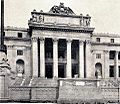
0 Response to "A Member of the House of Representatives Brainly"
Post a Comment